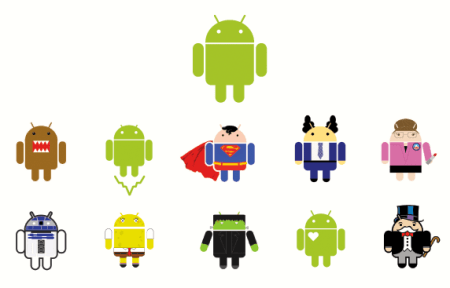From the New York Times Magazine on Sunday the 13th, “Who Made That Android Logo?” by Pagan Kennedy:
Irina Blok may have drawn one of the most recognized logos in the world, but her association with the green Android has not made her famous.
… The Android logo was born three years earlier, when Blok worked as a designer at Google. As Google prepared to endorse the Android software platform for mobile devices, Blok and her design-team colleagues were told to create a look for the software — something that consumers could easily identify. The logo, she was told, should involve a robot, and so she studied sci-fi toys and space movies — anything that might help her create a character. In the end, she took inspiration from a distinctly human source: the pictograms of the universal man and woman that often appear on restroom doors. She drew a stripped-down robot with a tin-can-shaped torso and antennas on his head.
While Blok worked on her design, she and her colleagues agreed that the logo, like the software, should be open-sourced. “We decided it would be a collaborative logo that everybody in the world could customize,” she says. “That was pretty daring.” Most companies, of course, defend their trademark from copycats, and million-dollar lawsuits have been filed over the rights to corporate insignia. This one would remain free.
In the years since, the Android logo has been dressed up as a ninja, given skis and skateboards and even transformed into a limited-edition Kit-Kat bar. Blok (who is now creative director at Edmodo, a social network for students and teachers) says that creating the logo was like raising a child: “You give a life to this individual, and then they have a life of their own.”
A display with the original (at the top) plus a selection of variants:
(I’m especially fond of row 1 #4, the pointy-headed boss from Dilbert.)
Trademarks and copyrights for logos are an issue for me, since I incorporate so many in my collages (search this site for “collage”), and I suspect I’m often skirting the law.
There’s been a movement to continue extending copyright for years and years — in particular the U.S. Copyright Term Extension Act of 1998, which extended copyright to the life of the author plus 70 years. (No doubt Disney will eventually seek another extension.) Here’s a logo representing opposition to the CTEA, using a reference to the pejorative characterization of it as the “Mickey Mouse Protection Act”:
 (#2)
(#2)
The logo combines the NO X red diagonal slash —
the Mickey Mouse ears —
the copyright symbol ©, and the infinity sign ∞.



Leave a Reply